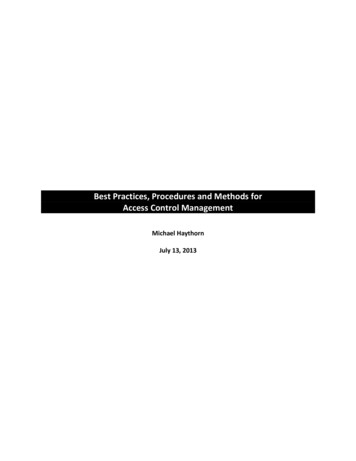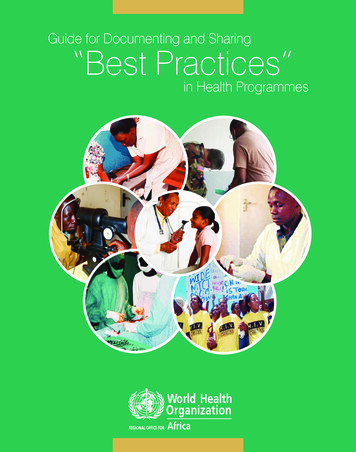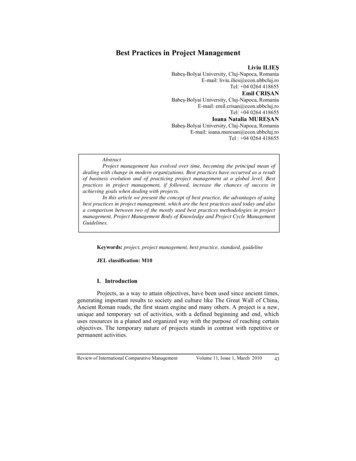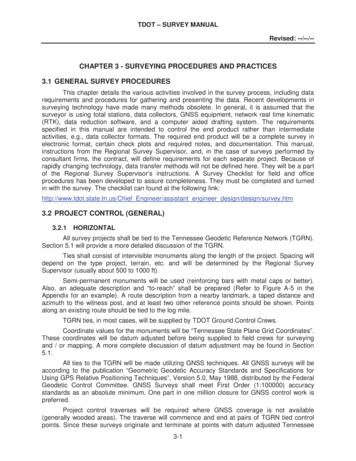
Transcription
Best Practices, Procedures and Methods forAccess Control ManagementMichael HaythornJuly 13, 2013
Table of ContentsAbstract . 2What is Access? . 3Access Control. 3Identification . 3Authentication . 4Authorization . 4-5Accountability . 5Put it All Together . 5-6Industry Standards and Best Practices . 7ISO/IEC 27002 . 7Requirements for Access Control . 7NIST 800-53(A) . 7Access Control Models . 8Least Privilege . 8Separation of Duties . 8Job Rotation . 9Mandatory Access Control . 9Discretionary Access Control . 9-10Role Based Access Control . 10Rule Based Access Control . 11Integrated Approach . 11Case Studies . 12Case Study 1: Government/Military . 12Case Study 2: Large Financial Company . 12-13Case Study 3: Small Internet Sales Company . 13Closing. 14References. 151
AbstractControlling access to information and information systems is a fundamental responsibility of informationsecurity professionals. The basic need to consume data creates a requirement to provide control overthe access necessary to use that data. It is this subject-object interaction that introduces risk that mustbe mitigated through methodological policy creation and enforcement. Access controls are managedthrough the provision of rules to grant/deny subjects who intend to access certain objects. These rulescan be defined and enforced through a number of means to create a manageable layered controlprocess. The overarching goal of access control is to facilitate the mitigation of risk to the object.In order to access data, multiple layers must be passed through including identification, authentication,and authorization. Actions of subjects must be monitored, creating accountability. Depending on therequirement for policy enforcement and level of sensitivity of the data to be protected, there aremultiple methods that can be implemented to control access. The principle of least privilege, separationof duties, job rotation, mandatory access control, discretionary access control, role based access controland rule based access controls are most commonly used.In addition, industry standards have been established both by government and private entities toidentify best practices. ISO/IEC 27002 standard outlines the management of access control policy andenforcement. The government created standard NIST 800-53 and 800-53(A) identifies methods tocontrol access by utilizing various models depending on the circumstances of the need.2
1What is Access?The necessity of control is created by the need for access. Access is essentially the ability of the subjectand the object to interact. In the terms for this paper, all access is logical, meaning that it exists on asystem and is typically a file, folder, program, system or process. The request for access is initiated bythe subject and is necessary in all information systems circumstances.1.1Access ControlAccess control is essential where there is sensitive data to protect or privileged actions to be performed.In order to control the use of these functions, there must be a way to limit access. Without this controlthere would be no ability to prevent unauthorized access to privileged data inside a system. Imagine ifany employee working for a soft drink company were able to see the secret formula or if all employeesworking for large private financial company were able to see the salary of their coworkers. Thesesituations would cause company collapse or employee mutiny because not all data is intended foreveryone.Thankfully there is access control in place to prevent the situations above. By using the proper means tocontrol who accesses data, along with when and where it is accessible this data can be protected inorder to maintain a competitive advantage, or establish a level of division required for an entity tosurvive.1.2IdentificationIdentification describes a method of ensuring that the subject is in fact who they claim to be. An identitycan be assigned to a user a user, program, or process and is used by the system to associate the subjectwith the identity stored on the system. An example of identification is a user name for a user who isaccessing a desktop through a log in screen. In this case the user name is unique to that user and isrequired for access to be granted. For the purpose of accessing a system or process, the identifier doesnot need to be unique to a user, but can be generic. The only requirement is that this identity be linkedto the process or program on the system so that it can be identified.Diagram 1.1 shows a typical identification request where the system is asking the subject to provide auser name that it will use to associate with a profile stored on the system:3
1.3AuthenticationIdentification is half of the typical login process. The next step is authentication where a user, programor process must provide some type of password, passphrase, token, biometric, or key that is matched tothe user name and matched to the credential stored on the system or on the network that is beingaccessed. Once authentication is passed, access is granted or denied to the system based on theinformation provided. For example, a UNIX user provides a user name and password to log into a UNIXsystem. The user is only authenticated at this stage yet still does not have access to perform andfunctions on the system.Diagram 1.2 shows a typical authentication request on a UNIX System where once the user name “root”is provided the system requests the password that is associated with the identifier:1.4AuthorizationThe next piece is the authorization of access that is granted to that user, program or process. Thiscontrol either allows or denies action based on rules that are defined inside the system pertaining tothat subject. Rules are defined in many ways and can be based on request, time, location, group, etc. Anexample of authorization is a subject requesting access to a network shared drive. In this example thesubject has successfully identified themselves and authenticated to the system. Their attempt toconnect to the shared drive must also be authorized by some control that will grant them this additionalaccess. If the user is granted the access they will be able to connect to the shared drive. If the user doesnot have the necessary authorization to connect they will be denied access. Authorization is whereaccess control is established and can be implemented at both the macro and micro level depending onthe sensitivity of the data and the policy being enforced.4
Diagram 1.2 displays the process of identification, authentication and authorization through the use of aflow chart that can grant or deny access based on the information given and the rules it has beensupplied:1.5AccountabilityFinally in order to enforce the misuse of policy once access has been granted, or prevent repeatedmalicious access attempts there must be some form of accountability. Accountability can use variousmethods to record or capture events for additional review. This event log can include every accessrequest, both positive and negative, subject login times and locations, subject actions upon login, etc.This information is stored and can be used for investigative purposes or for reporting of usage statisticsfor audit. Accountability is essential to be able to provide proof of action and without this piece it wouldmuch more difficult to reduce risk associated with the access that has been granted in the earlier stages.1.6Put it All TogetherRequiring the subject to provide Identification, authentication and authorization as well as holding themaccountable for their actions allows the integrity of the object to be maintained at a much higher levelof confidence. As we have seen in the examples above, identity, authentication and authorization arerequired in conjunction before an object can be accessed. There are cases where a user may be able toidentify themselves, authenticate but may not be authorized to perform an action beyond that. On theother hand a user may be authorized to access a resource, but is unable to identify themselves with a5
proper user name. The same is true for a password credential, a user may have proper identificationinformation but is unable to authenticate because the password the have supplied is either wrong orexpired. In order for the subject to access the object each of these pieces must be present andaccessible.6
2Industry Standards and Best PracticesIn order to identify industry best practices and standardize access control principles there must be anentity or entities who are responsible for this role. In the case of access control standards, there are twomain groups focused on these best practices.2.1ISO/IEC 27002ISO/IEC 27002 is an information security standard that is published by the International Organization forStandardization (ISO) and the International Electrotechnical Commission (IEC). This standard specificallydefines access control and how access should be managed by information security personnel. Accesscontrol is included as a section within this standard to define the best practices to suitably control logicalaccess to network resources, applications, functions and data.“The control objectives and controls in ISO/IEC 27002:2005 are intended to be implemented to meet therequirements identified by a risk assessment. ISO/IEC 27002:2005 is intended as a common basis andpractical guideline for developing organizational security standards and effective security managementpractices, and to help build confidence in inter-organizational activities.” [1]2.1Requirements for Access ControlKey highlights of this standard include the business requirements for access control, user accessmanagement, responsibilities and definitions and best practices of the different types of access. Thestandard includes multiple detailed sections aimed at outlining access control for organizations so thatthey can implement these best practices in the most effective manner.2.2NIST 800-53(A)After the Federal Information Security Management Act (FISMA) was passed in 2002 a statutoryprovision to ensure that agencies comply with mandatory processing standards. The National Instituteof Standards (NIST) is the technology measurement and standards department was asked to developstandards and guidelines for the federal government. The NIST handbook is similar in informationcovered to the ISO/IEC 27002 but since it is tied to the governmental practices is goes into significantlymore detail related to security controls and assessing the adequacy of the controls.NIST 800-53 addresses multiples aspects of access, including management, technical and operationalroles. [2]7
3Access Control ModelsThe standards and best practices from above can be used in a practical means through several differentmethods and models that are deemed appropriate depending on what type of security a companywants to maintain. There are many models available to use as a template for access control, but themost commonly referenced methods include least privilege, separation of duties, job rotation,mandatory access control, discretionary access control, role based access control and rule based accesscontrol. In this section we will go into greater detail about these models and their usage.3.1Least PrivilegeThe principle of least privilege is simple, no user should have any access above what is required toperform their tasks at any given time. This approach, when put into practice in its simplest form is bothdifficult to experience from an end user perspective and difficult to manage from an administrativeperspective. In many cases users do not know what access they would need to perform their tasks andwithout extensive knowledge of the environment, the team provisioning the access may not know whataccess they need either. This method of access control does not scale well and can be prohibitivelyexpensive and difficult to implement and maintain. Because of that, generally when this principle isused, it is used in conjunction with another approach.3.2Separation of DutiesThe method of separation of duties states that no one person be able to handle a transaction frombeginning to end. This method addresses fault or fraud by preventing someone from maliciously oraccidentally initiating and completing a transaction without an additional layer of input. This methodreduces the likelihood of fraud by introducing multiple variables into the process. A line of segregation isestablished by creating different layers of responsibility and ability to perform these transactions. Thismethod is much like an assembly line where no single worker completely builds the finished productfrom start to finish. Instead each worker has their assigned task that contributes to the final product butdoes not create it.Diagram 3.1 displays this method using the assembly line example to show that no one user cancomplete a transaction from beginning to end:8
3.3Job RotationThe concept of job rotation is similar to separation of duties where no one person has the ability tocomplete a transaction, except in this case a time limit is introduced. Job rotation requires thatindividuals change their roles and thus the functions they can perform at regular intervals. This rotationis to prevent exploiting a process or situation for an extended period of time. This method of accesscontrol is not typically used without the addition of another method. This method is frequentlyemployed and has introduced several possible benefits including an increased diversity of skill andexperience as well an increased job satisfaction through job change.3.4Mandatory Access ControlMandatory access control or MAC is based on subject and object access level and is frequentlyemployed in federal government and military instances. The basic principle of mandatory access controlinvolves a central authority identifying subject’s and object’s appropriate access level. Subjects inheritthe access to the objects at their same level. There is no access granted above their level. In some casesthis method is also applied to prevent access below a subject’s level as well. This method of accesscontrol is a high security and requires a great detail of management overhead because each object mustbe assigned a label which will then allow or deny access to subjects depending on the level assigned.It is important to note that mandatory access control is a non-discretionary method, meaning that a useris not able to change the permissions on any object, including objects they own. Permission assignmentsmust be performed by the central authority that is responsible for maintenance of the access controlsystem. [3]Diagram 3.2 displays the concept of mandatory access control where there is a distinct division betweenlevels of access:3.5Discretionary Access ControlDiscretionary access control or DAC uses the discretion of the subject to control access. DAC uses thepermissions assigned by the owners of the objects to grant or deny access. This model distributes theload of access control to the subjects which removes the need for a central authority. This method isless secure than a non-discretionary access control method due to the lack of centralized authority.Decisions of access appropriateness are made by the subjects themselves and can frequently introducerisk. This method is common in small to medium sized organizations due to the reduction in overheadthus reducing cost and time necessary to implement access controls.9
Diagram 3.3 displays a user granting access to an object that they own based on their own discretion:3.6Role Based Access ControlRole based access control or RBAC requires a central authority to determine the access that will begranted to the role. Access is grouped by role across an organization and users can be in multiple groupsdepending on their role. No access is provided outside of access that is granted inside of the role. Thispractice frequently leads to providing more access than is required to complete necessary tasks.Typically, role based access control is part of a multi-level access system, like in the case of a commercialentity where there are distinct levels between necessary job roles.Role based access control is similar to discretionary access control in that the privileges are associatedwith the role of the subject and not controlled by a central authority. Once a role is achieved all access isautomatically granted to that user for that role.Diagram 3.4 displays how roles can be divided in an organization to allow users of the same title toaccess the same resources:3.7Rule Based Access Control10
Rule based access control (also known as RBAC) uses a set of rules provisioned to subjects defined by acentral authority. This method of access control is non-discretionary and can be extremely granulardepending on the sensitivity of the data. Rules can be defined inside of access control lists for useraccess to each object. Since all permissions are controlled by a single authority, the overhead can besimilar to mandatory access control. Rule based access control can also be used to permit access duringa certain period of time, or could require a subject to invoke access each time they intend to use it.Diagram 3.5 shows how a central authority can define rules for subject access to objects:3.8Integrated ApproachAlthough one method identified above can be used as an access control solution, this is not typically thecase. Most organizations will choose to use a combination of these methods as they are needed basedon the requirement of the organization. Using an integrated approach allows companies to base accesscontrol on their own standards and needs.For example, a company might use role based access control for anyone with the title of databaseadministrator, but may also use rule based access control to grant exception access beyond what isgranted through the role. Additionally, a company may use a combination of rule based access controland least privilege access, where users are granted access to the objects they require only for the periodof time they require them. Once access is invoked the ability to access the object only lasts for a periodof time until it is automatically removed to prevent improper use.11
4Case StudiesIn order to understand how these access control methods are applied it is best to relate real worldscenarios that can be applied to the concepts introduced in a best practice. The following section willexemplify three cases where a combination of methods are used to create a security policy that is suitedfor the situation.4.1Case Study 1: Government/MilitaryIn this example we will use the United States Military as the organization, but these principles can beapplied broadly across governmental entities due to the relation of privilege groups. Militaryorganizations have a defined range of classification levels that a central authority is responsible forassigning. This non-discretionary access method is the most demanding, but is necessary given thesensitivity of the data. These classifications include top secret, secret, confidential, restricted andunclassified. Starting at the bottom, unclassified data has been made available to the public, and topsecret data is only available to the subjects who have the proper clearance, or access.This military access control method follows the mandatory access control model, which preventssubjects and objects from reading above and in some cases writing below the access level granted. Anengineer with a confidential level clearance is not able to read data above the confidential classificationand a subject with a restricted level clearance is not able to write data that is unclassified.The objective of this mandatory access control is to first identify what type of data or object you haveand then allow subjects with that equal access to use it. This type of access control requires a centralauthority to make the decisions about the classification of the subjects as well as classification of theobjects. There is no discretion given to the subjects because they may not make the right decision aboutthe access level, even with data they create.This type of access control method is extremely time consuming, expensive and has a high level ofoverhead to maintain, but it is necessary in order to keep the most sensitive data secure fromindividuals who should not have access to it.4.2Case Study 2: Large Financial CompanyIn this example, we introduce a large financial company with extremely sensitive personal customerdata to protect. This company does not have the same security levels defined as the militaryorganization from the example above. Instead of the use of mandatory access control, the financialcompany will use an integrated approach combining methods based on the type of access and the userthat will access it. The most common approach will be based on the role of the subject. Multiple ruleswill be defined for a single role, and a user is only allowed to be in one role at a time. On top of thisaccess, subjects will be granted exception or rule based access to objects that are required beyond theirrole. This type of access is necessary to prevent subjects from gaining unnecessary access from a roleand maintains this exception access through a central authority.In order to be added to a role and then given rule exception access subjects must be granted thisapproval by the custodians or owners of the role and applications inside of rules. This prevents usersfrom granting access to themselves and provides an audit trail that access was approved based on adefined business justification for each user.12
The most privileged access in this large financial company is write access on a trading platform, so thisaccess is managed through a special type of rule based access control that uses the concept of leastprivilege. Users must invoke their access to these functions only when they need them. Once the accessis invoked, the functions are available to them, but they have a limited of time (usually less than 24hours) to perform their required actions before the access is lost.Financial companies have a wide range of subjects and objects which is why a centrally managedadministration authority is essential to enforcing the policy and mitigating risk to the firm. Users in thisinstance also play a key role because they are the most knowledgeable about what they need toperform their duties, and any access above this function must be removed.4.3Case Study 3: Small Internet Sales CompanyThe final case study involves less sensitive data and is a typical scenario for most small businesses like aninternet sales company. For this example the company has a sales and marketing department, humanresources, and a technology department. Each department has data that should not be available to theother groups, but the company lacks the time and money required to centralize the authority of accessto this data.Discretionary access allows the subjects to assign the privileges to the objects they own and maintain. Ahuman resources analyst who holds the salary information of all employees will make this documentonly available to those in her department because of the sensitivity of the data. This is done using aWindows access control rule that allows only a certain number of employees to access this data.Similarly the sales manager who has access to company sales statistics and records does not share thisdata with anyone but those who are authorized to see it. In some cases, data can move between groupsespecially in the example of a technology engineer who owns a database that houses the employeedirectory. This data is accessible to everyone because it is something everyone needs.DAC has very low overhead in this situation and the responsibility is on the subjects to maintain accesscontrol. The risk is higher in this type of example for that reason, but small companies take this type ofrisk because is necessary to avoid the cost of another more involved solution.13
5ClosingManaging access control can be approached in different ways. But in the end, in order for the system tofunction effectively at its most basic level, a subject must have access to an object in order to performits required task. Controlling this access based on a predefined rule is essential to mitigate risk of theobject being unprotected.In order to achieve this function, the subject must first properly identify itself, adequately authenticateto the system and then be appropriately authorized to perform the action it is requesting. In most casesthis is done though an integrated process created based on the need of the entity responsible for theobjects. Without the methods, there would be no reason to control access because there would be nosystem at all.14
6References[1] Disterer. (2013). Iso/iec 27000, 27001 and 27002 for information security management. Journal ofInformation Security, 4(92-100)[2] Locke. (2009). Recommended security controls for federal information systems and organizations.3(800-53)[3] Osborn. (n.d.). Mandatory access control and role-based access control revisited. 31-40.Ballad, B. (2010). Access control, authentication, and public key infrastructure. (pp. 238-264). Sudbury,MA: Jones & Bartlett Learning.Cascarino, R. (2012). Auditor's guide to it auditing, second edition. Hoboken, NJ: John Wiley & Sons Inc.Dubrawsky, I. (2009). Eleventh hour security. (pp. 92-101). Burlington, MA: Elsevier Inc.Ferraiolo, D., Cugini, J., & Kuhn, R. (n.d.). Retrieved /ferraiolo-cugini-kuhn-95.pdfNIST. (n.d.). Retrieved from website: IR-7316.pdfSeidl, D. (2013). Comptia security training kit. (pp. 380-386). Sebastopo, CAl: O'Reilly Media, Inc.Techotopia.com. (n.d.). Retrieved fromhttp://www.techotopia.com/index.php/Mandatory, Discretionary, Role and Rule Based Access Control15
2.1 Requirements for Access Control Key highlights of this standard include the business requirements for access control, user access management, responsibilities and definitions and best practices of the different types of access. The standard includes multiple detailed sections aimed at outlining access control for organizations so that











